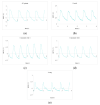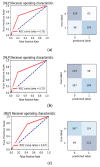Discrimination of the Cognitive Function of Community Subjects Using the Arterial Pulse Spectrum and Machine-Learning Analysis
- PMID: 35161551
- PMCID: PMC8838619
- DOI: 10.3390/s22030806
Discrimination of the Cognitive Function of Community Subjects Using the Arterial Pulse Spectrum and Machine-Learning Analysis
Abstract
Early identification of cognitive impairment would allow affected patients to receive care at earlier stage. Changes in the arterial stiffness have been identified as a prominent pathological feature of dementia. This study aimed to verify if applying machine-learning analysis to spectral indices of the arterial pulse waveform can be used to discriminate different cognitive conditions of community subjects. 3-min Radial arterial blood pressure waveform (BPW) signals were measured noninvasively in 123 subjects. Eight machine-learning algorithms were used to evaluate the following 4 pulse indices for 10 harmonics (total 40 BPW spectral indices): amplitude proportion and its coefficient of variation; phase angle and its standard deviation. Significant differences were noted in the spectral pulse indices between Alzheimer's-disease patients and control subjects. Using them as training data (AUC = 70.32% by threefold cross-validation), a significant correlation (R2 = 0.36) was found between the prediction probability of the test data (comprising community subjects at two sites) and the Mini-Mental-State-Examination score. This finding illustrates possible physiological connection between arterial pulse transmission and cognitive function. The present findings from pulse-wave and machine-learning analyses may be useful for discriminating cognitive condition, and hence in the development of a user-friendly, noninvasive, and rapid method for the early screening of dementia.
Keywords: Mini-Mental State Examination; community subjects; dementia; machine learning; pulse; spectral analysis.
Conflict of interest statement
The authors declare no conflict of interest.
Figures





References
-
- Creavin S.T., Wisniewski S., Noel-Storr A.H., Trevelyan C.M., Hampton T., Rayment D., Thom V.M., Nash K.J., Elhamoui H., Milligan R., et al. Mini-Mental State Examination (MMSE) for the detection of dementia in clinically unevaluated people aged 65 and over in community and primary care populations. Cochrane Database Syst. Rev. 2016;13:CD011145. doi: 10.1002/14651858.CD011145.pub2. - DOI - PMC - PubMed
MeSH terms
Grants and funding
LinkOut - more resources
Full Text Sources
Medical

